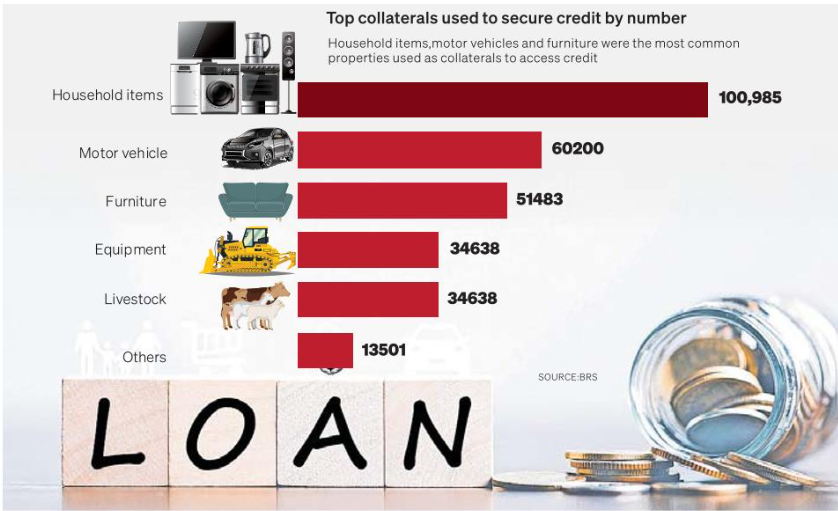
CARS, FRIDGES, TVS TOP LIST OF COLLATERAL FOR SH5.1TRN LOANS
By: Brian Ambani, Business Daily
More Kenyans are mortgaging household items including televisions, fridges, tables, and sofa sets to secure loans as borrowers turn to expensive short-term credit to meet daily needs after real wages dropped for the fourth consecutive year.
The Business Registration Service (BRS) under the Attorney-General’s office reveals that 100,985 pieces of household items were used for loans in the year to June 2023, which is more than any other type of movable property. The BRS, formerly known as the Registrar of Companies, is the custodian of the Movable Property Security Rights (MPSR) registry, through which creditors such as banks list their rights over goods used by borrowers as loan securities. Household items are increasingly being used as security to secure low-value loans because they are readily available, and for creditors, these items can easily be auctioned to recover defaulted loans. Motor vehicles were the second most used movable assets that borrowers used to secure loans, with creditors registering 60,200 vehicles during the period. Furniture and equipment were also heavily used for borrowing, with 51,483 and 36,236 pieces respectively used to secure loans during the period as livestock (34,638) closed the top five most collateralized movable assets.
The increased use of these goods comes when separate surveys indicate that more households are tapping loans to meet their daily needs such as food, health and rent costs.
This is happening when pay increases have for the fourth year in a row lagged inflation, narrowing households’ disposable income. “During the period between July 2022 and June 2023, the most preferred type of movable collateral used to secure credit included household items, motor vehicles and furniture,” said BRS. Other top movable assets that were charged against loans include stock trade (8,002), acquired property (3,131), securities (2,573), inventory (1,890), crops (1,495) and bank accounts (1,333). The list also includes intellectual property (610), documents title (529), consumer goods (257) and negotiable instruments (23). According to the BRS, movable assets – in addition to immovable property such as land and buildings – were used to secure Sh5.1 trillion worth of loans during the period.
“The cumulative amount of credit facilitated by MPSR from July 2022 to June 2023 amounted to approximately Sh5.1 trillion,” said the agency.
This comes when individuals and firms are navigating a turbulent economic environment underpinned by high taxation and inflation which has the business environment worse. Although the economy grew at 5.6 percent in 2023 from 4.9 percent in 2022, it struggled to generate new jobs, and real wages shrank in the face of low pay raises and high inflation. The 2024 Economic Survey published by the Kenya National Bureau of Statistics (KNBS) said the average pay increase in 2023 was 2.8 percent, while real wages adjusted for inflation fell by 4.1 percent. This meant that annual real wage earnings per employee in 2023 decreased to Sh667,300, or Sh55,608 a month, from Sh696,144 or Sh58,012 monthly in 2022. Firms also froze pay increases last year as they experienced higher operating costs due to inflation and higher taxes, combined with reduced purchasing power among their customers due to the same factors.
Employers have also warned that it will take longer for pay raises to return to pre-Covid levels, with firms fretting over business uncertainties despite the economic rebound.
Taxes proposed in the Finance Bill 2024 are also likely to weigh heavily on businesses, should they be approved later this month. This combination of low pay increases and high inflation has, therefore, resulted in growing household consumption pressures and cash flow headache for businesses, forcing them to release assets to secure loans. Kenya enacted the Movable Property Security Rights Act in 2017 which provided a legal framework that governs the use of movable property as collateral which led to the establishment of the register in May 2017 to replace the chattels registry. This has enabled borrowers to use such assets to secure loans, while lenders have gained more confidence to lend to such borrowers as such assets cover their outstanding loans in case of default.
The increased demand for loans, as well as the growth in the formalization of collateral use, has seen more creditors join the market.
According to the BRS, some 170,124 creditors issued loans to borrowers during the period, marking an increase of 40.19 percent compared to 121,350 creditors in the previous year. Over the last five years, most of the household loans in Kenya have been spent on food, school fees, rent and other subsistence needs, in a departure from when credit was mainly used on investments and buying assets such as houses, land and motor vehicles. Banks have said that borrowing for short-term needs has been a key driving factor in the growth of their loan book. They have also seen a steady increase in the stock of non-performing loans, reflecting the tough economic conditions facing borrowers.
At the end of January, the latest data from the Central Bank of Kenya shows, the volume of bad loans in the banking sector stood at Sh638.4 billion, equivalent to 15.1 percent of the sector’s gross loans of Sh4.22 trillion.
A year earlier, bad loans amounted to Sh496.6 billion or 13.4 percent of the total.


